Kinner Kailash
Introduction
Kinner Kailash well known as Kinnaur Kailash is a mountain peak in Himachal Pradesh, which holds spiritual significance as the resting abode of lord Shiva.
There are many legends and stories about the Kinner Kailash from different generations, and some have their presence in old scripture and literature.
The Kinner Kailash peak is one of the Panch Kailash believed to be the resting abode of Lord Shiva and Mata Parvati. The Kinner tribe, who reside in Kinnaur were blessed by lord Shiva who made this peak his resting abode, honoured by having lord Shiva in their area the tribe became devotees of lord Shiva, and after some time the peak was named after the tribe “KINNER KAILASH”.
Kailash Mansarovar is first in Panch Kailash, Adi Kailash is second, Shrikhand Mahadev is third, Kinner Kailash is fourth, and Mani Mahesh Kailash is fifth.
The term “Kinner” has various mythical meanings, and has been mentioned in multiple pieces of literature, including the Shiv Purana, Vishnu Purana, Matsya Purana, and Ramayan. This collection of epics honours the Kinners as a distinctive clan of demi-gods who stand halfway between mortals and gods.
Kinnaur Kailash is a sacred mountain revered by Hindus and Buddhists.
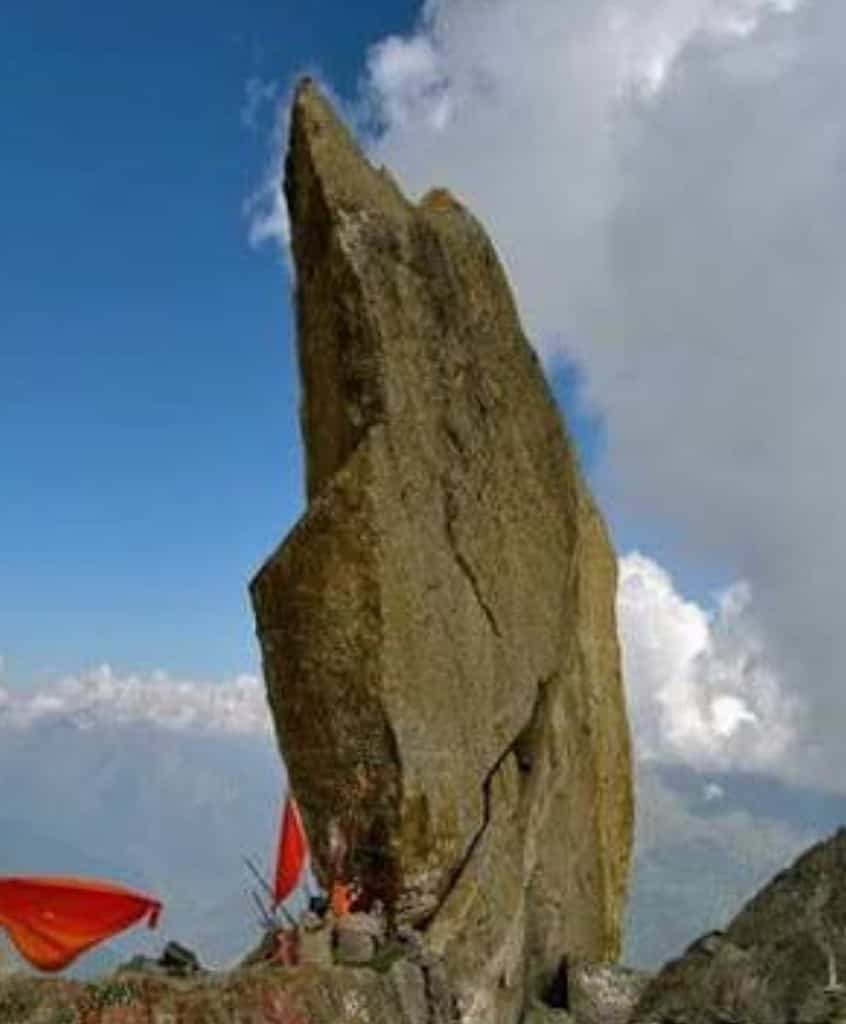
Where Kinner Kailash is located
Kinner Kailash is a part of the Himalayas, situated in the Kalpa region of Kinnaur district, in the northern state of Himachal Pradesh, India. The mountain is characterized by its striking resemblance to the iconic Shiva Linga, with its towering peak and distinct ridges creating a mesmerizing visual.
Kinner Kailash altitude
| S.NO. | Name | Altitude | |
| Meters | Feets | ||
| 1 | Kinner Kailash | 4572 | 15000 |
| 2 | Bheem Dwar | 3780 | 12400 |
| 3 | Parvati Kund | 3018 | 9900 |
| 4 | Ashiqui Park | 3581 | 11750 |
| 5 | Bada Patthar(large rock) | 2565 | 8415 |
| 6 | Bada Ped(large tree) | 2957 | 9700 |
| 7 | Tangling village | 2149 | 7050 |
Kinner Kailash Yatra
When Kinner Kailash yatra starts
The weather conditions favourable for Kinner Kailash Yatra are Between June to September.
But officially the Yatra is not open for the whole of the summer, the official Yatra is mostly open for the August month only.
There are so many reasons that make this yatra difficult like high elevation, long stretches with steep slopes, stone pelting moraine areas, and harsh environment due to snow and glaciers.
Kinner Kailash Parikrama
Another captivating myth associated with Kinnaur Kailash is the legend of the Kinner Kailash Parikrama, a ritual circumambulation of the mountain. According to the myth, Lord Shiva and Parvati performed this sacred ritual, which is said to bestow immense spiritual blessings and purification upon those who undertake the journey. The Kinnauri Kailash Parikrama is a challenging trek that takes devotees through rugged terrain, ancient monasteries, and pristine alpine meadows, offering a truly transformative experience.
Best time to visit Kinner Kailash
The best time to visit Kinnaur Kailash and the surrounding region is largely dependent on the trekker’s preferences and the weather conditions. However, certain periods of the year are generally considered the most favorable for a visit.
The summer months, from June to September, are often the most popular time for visiting Kinnaur Kailash. During this time, the weather is generally mild and dry, with clear skies that offer breathtaking views of the mountain and the surrounding landscape. The high-altitude meadows are also in full bloom, creating a vibrant and picturesque backdrop for the trekker’s journey.
For those seeking a more serene and less crowded experience, the shoulder seasons of spring (April-May) and autumn (October-November) can be excellent choices. During these times, the weather is still relatively pleasant, and the crowds are generally smaller, allowing for a more intimate connection with the natural and cultural elements of the region.
It’s important to note that the winter months, from December to March, can be quite challenging for visiting Kinnaur Kailash, as the region is blanketed in snow and the temperatures can drop significantly. However, for those willing to brave the harsh conditions, the winter season can offer a unique and enchanting perspective, with the mountain and its surroundings taking on a magical, snow-covered appearance.
- How to reach – The Kinner Kailash is in the Kinnaur District, headquarters is Reckong Peo which is well connected to all kinds of transportation services.
Accessibility
Airport – The nearest airport is Bhuntar in Kullu district. The second airport is Shimla and the third nearest airport is Chandigarh.
Railway station – The nearest Railway station is Shimla which is 200 km from Tangling.
Bus station – The nearest Bus station is Reckong Peo which is 30 km from Tangling.
Bike ride – This is the most adventurous mode of travel and my personal favorite. The curvy Himalayan roads of Himachal Pradesh, breathtaking views of the snow-capped mountains, and the feeling of chilled breeze on the route to Shrikhand Mahadev Kailash are unparalleled.
The freedom of doing anything how you see fit, your itinerary, time stamp, no waiting for buses, trains, or flights, and no worry of keeping up with them are second to none.
- Distances of Tangling village from the main cities
Delhi 600
Chandigarh 356 km
Shimla 259 km
Bhuntar 270 km
Route for Kinner Kailash
We’ll consider Our country capital Delhi as a starting point.
- Air – Delhi Airport – Bhuntar Airport – Jibhi – Rampur – Karcham – Tangling village(trek starts here) – Ashiqui Park – Bheem Dwar – Parvati Kund – Kinner Kailash.
- Train – Delhi – Chandigarh – Kalka – Shimla – Narkanda – Rampur – Tangling village(trek starts here) – Ashiqui Park – Bheem Dwar – Parvati Kund – Kinner Kailash.
- Bus – Delhi – Ambala – Chandigarh – Shimla – Narkanda – Rampur – Tangling village(trek starts here) – Ashiqui Park – Bheem Dwar – Parvati Kund – Kinner Kailash.
- Bike – Delhi – Ambala – Jirakpur – Panchkula – Shimla – Tangling village(trek starts here) – Ashiqui Park – Bheem Dwar – Parvati Kund – Kinner Kailash.
Who can go to Kinner Kailash
How to prepare for the trek – This trek is difficult to moderate, with high altitudes and long stretches. So it is recommended that you should prepare accordingly. You should also read the article of India Hikes on how to prepare for Kinner Kailash.
- Start jogging at least 1 to 2 months prior. Benchmark is 5 km in 25 minutes.
- Keep an eye on your cardiovascular health and breathing and try to regulate them.
- Do some strength training as well, because you would have to carry your basic luggage(water, rain gear, basic medicine, phone, and camera maybe). Strength training like squats, plank, and pushups.
- Stretching the hamstrings, quadriceps, back, and shoulder regularly can prevent strain and sprain on the trek due to the long distances.
Registration – The pilgrims must register themselves first to visit Kinner Kailash. The registration can be done on the official Himachal Pradesh government website.

Medical certificate – Kinner Kailash is a high-altitude Yatra which is why the medical certificate from any recognized government hospital is mandatory and should be valid for one week. The registration and medical certificates. Medical fitness certificate form pdf.
Kinner Kailash trek
The journey to Kinnaur Kailash is not for the faint of heart, as it involves a challenging trek through rugged terrain, high-altitude passes, and remote villages. However, the rewards of this journey are immense, as the trekker is rewarded with breathtaking vistas, spiritual encounters, and a deep connection with the natural world.
The starting point for the Kinnaur Kailash trek is typically the town of Recong Peo, which serves as the gateway to the region. From here, the trek makes its way through the Kinnauri valleys, passing by traditional villages, ancient monasteries, and lush meadows. As the trekker gains altitude, the landscape transforms, with the towering peaks of Kinnaur Kailash coming into view.
One of the most challenging sections of the trek is the crossing of the Parikrama Pass, a high-altitude pass that offers panoramic views of the Kinnaur Kailash massif. The pass, which can reach elevations of over 5,000 meters, requires a significant amount of physical and mental preparation, as the trekker must go through steep, snow-covered terrain and deal with the effects of high altitude.
Upon reaching the base camp of Kinnaur Kailash, the trekker is greeted with a truly awe-inspiring sight. The 79-foot-high Shiva Linga dominates the landscape, seemingly reaching up towards the heavens. This is the point where the spiritual significance of the mountain becomes visible, and feelable, as the trekker is surrounded by the energy and reverence of the sacred site.
- Trek Itinerary
Day 1: Trek from Tangling village(7050 ft) to Ashiqui Park (11750 ft)
Day 2: Ashiqui Park (11750 ft) to Bheem Dwar (12400 ft)
Day 3: Bheem Dwar (12400 ft) to Kinner Kailash(15000ft) Peak summit; return to Bheem Dwar.
Day 4: Bheem Dwar (12400 ft) to Tangling village (7050ft)
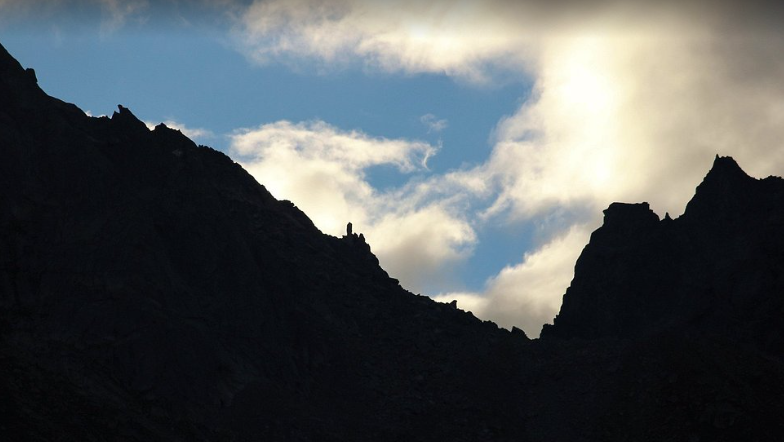
Is Kinner Kailash trek difficult
Yes, Kinner Kailash is categorised as a difficult trek due to the high elevation that goes up to 15000 feet, long stretches with steep slopes, stone pelting moraine area, and harsh environment.
Kinner Kailash trek distance –
The distance of the Kinner Kailash trek is 18 to 19 km. The trek starts from Tangling village(7050ft) which is a base camp for the Kinner Kailash(15000ft) Yatra.
Precaution for Kinner Kailash trek
Acclimatize Properly: The high-altitude environment of Kinnaur Kailash can be challenging, and it’s crucial to allow your body sufficient time to acclimate to the changes in elevation.
Pack Wisely: The Kinnaur Kailash trek can be physically demanding, so it’s important to pack the right gear and equipment. Invest in high-quality, warm clothing, sturdy hiking boots, and essential camping gear.
Hire a Reputable Guide: The terrain in Kinnaur can be treacherous, and it’s highly recommended to hire an experienced local guide who is familiar with the region.
Stay Flexible: The weather and conditions in the Himalayas can be unpredictable, so it’s essential to maintain a flexible mindset and be prepared to adjust your plans as needed.
Kinner Kailash Trek opening –
Kinner Kailash Trek usually opens in August.
In 2024 the Yatra opened from 1 August to 26 August.
Weather
- Summer – The summer season is April to June but the condition is not suitable for trekking because the ice and snow of previous winter starts melting and creates slush on the path.
- Winter – From November to February is the winter season when the snowfall and chilly weather are at their peak making the environment harsh and impossible to climb even for the locals and professional trekkers.
- Rain – Rain usually pours in June and July mainly although the mountains are known to have unpredictable rain that can fall at any time throughout the year but June and July are more prone to rain.
While July and August are the only time for the yatra to happen when the snow of last season has been washed away in the rain and fresh snow hasn’t come yet.
- Spring – February to March is the spring season but due to the high altitude it snows here just like the winters.
Why Kinner Kailash is famous
Spiritual Significance – Kinnaur Kailash, also known as Kinner Kailash, holds immense spiritual significance for both Hindus and Buddhists. This sacred mountain is revered as an abode of Lord Shiva, the supreme deity in Hinduism, and is believed to be a manifestation of the celestial Mount Kailash in the Tibetan Himalayas.
According to Hindu mythology, Kinnaur Kailash is the place where Lord Shiva and his consort Parvati reside, making it a highly revered pilgrimage site for devotees. The mountain’s striking resemblance to the iconic Shiva Linga, a symbolic representation of Lord Shiva, further reinforces its sacred status. Pilgrims from across India and beyond flock to Kinnaur Kailash to seek the blessings of the divine couple and to participate in the various religious rituals and festivals held in their honor.
The spiritual significance of Kinnaur Kailash extends beyond Hinduism, as it is also revered by Buddhists. The mountain is believed to be the abode of Demchok, a wrathful deity associated with the Vajrayana branch of Buddhism. Buddhists from the neighboring regions of Spiti and Ladakh often embark on pilgrimages to Kinnaur Kailash, seeking spiritual enlightenment and the blessings of the divine. The presence of several ancient Buddhist monasteries and shrines in the region further underscores the deep-rooted Buddhist influence in this sacred landscape.
One of the Kailash – The Kinner Kailash is of the Panch Kailash Parvat. In terms of importance, it is the fourth Kailash. First is Kailash Mansarovar and Adi Kailash is second, Shrikhand Mahadev is third and Mani Mahesh Kailash is fifth.
79-foot-high Shivalinga – On the top of Kinner Kailash mountain there is a 79-foot-high Shivalinga that is the main attraction and center point of this Yatra. This Shivalinga changes its colour during the day.
Kinner Kailash Story
One of the most prominent myths surrounding Kinnaur Kailash is the tale of the celestial Kinners, a mythical race believed to be the descendants of Lord Shiva and Parvati. According to the legend, the Kinners were highly advanced and spiritual people who lived in the lush valleys and high-altitude meadows of the Kinnaur region.
The Kinners are also believed to have been the guardians of the sacred Kinnaur Kailash, protecting its sanctity and ensuring that only the most worthy pilgrims were granted access to the mountain. The local Kinnauri people still revere their ancestral deities and the sacred landscapes they inhabited.
Significance and importance of Kinner Kailash
Glaciers and River – The region’s geography is further defined by the presence of several major rivers, including the mighty Sutlej River, which flows through the heart of Kinnaur. These rivers, along with their tributaries.
Surrounding the Kinnaur Kailash peak are a series of high-altitude lakes, including the serene Chandranahan Lake and the sacred Shingchaling Tso.
Tourism – One of the most significant landmarks near Kinnaur Kailash is the ancient Nako Monastery, a Buddhist monastery that dates back to the 11th century. This serene and well-preserved monastery is renowned for its stunning wall paintings, intricate wood carvings, and the tranquil atmosphere that permeates its halls. Visitors to the Nako Monastery can engage in meditation sessions, attend religious ceremonies, and learn about the rich Buddhist heritage of the region.
Another must-visit attraction in the Kinnaur region is the Sangla Valley, a lush and verdant oasis nestled amidst the towering peaks. The valley is home to traditional Kinnauri villages, where visitors can immerse themselves in the local culture, sample delicious regional cuisine, and explore the area’s rich natural heritage, including the Baspa River and the Sangla Kanda meadows.
The Chitkul Village, situated near the Indo-Tibet border, is another enchanting destination in the Kinnaur region. This picturesque village, often referred to as the “last village of India,” offers a glimpse into the traditional way of life of the Kinnauri people, with its charming wooden houses, ancient temples, and stunning views of the surrounding mountains.
Kinner Kailash Ashiqui Park
Ashiqui Park Kinner Kailash is a meadow, a grassland. Sometimes you may find it all white buried under the snow. This area is believed to be the place where lord Shiva and goddess Parvati met and they used to roam these meadows together that’s the reason locals call it Ashiqui Park.
Ashiqui Park now has been renamed Ganesh Park or Kailash Darshan Park.
Kinner Kailash and Shrikhand Mahadev
Shrikhand Kailash is situated in the Nirmand region of Kullu district.
Kinner Kailash is situated in the Kalpa region of the Kinnaur District
Shrikhand Kailash and Kinner Kailash are different but both are situated in Himachal Pradesh and are very close to each other.
Shrikhand Kailash is related to Lord Shiva, Lord Vishnu’s Mohini form, and Demon Bhasmasur.
While
The Kinner Kailash peak or area is believed to be the resting abode of Lord Shiva and Mata Parvati. The Kinner tribe, who reside in Kinnaur, were honoured by having the mountain named after them “Kinner Kailash”.
The term “Kinner” has various mythical meanings associated with it and has been mentioned in various pieces of literature, including the Shiv Purana, Vishnu Purana, Matsya Purana, Ramayan, and Rajtaringini. This collection of epics honours the Kinners as a distinctive clan of demi-gods who stand halfway between mortals and gods.
Is Kinner Kailash and Shrikhand Mahadev same
No, Kinner Kailash and Shrikhand are not the same. Both are part of Panch Kailash and devoted to Lord Shiva and both are in Himachal Pradesh, raising the question that is Kinner Kailash and Shrikhand Mahadev same, but no they are not.
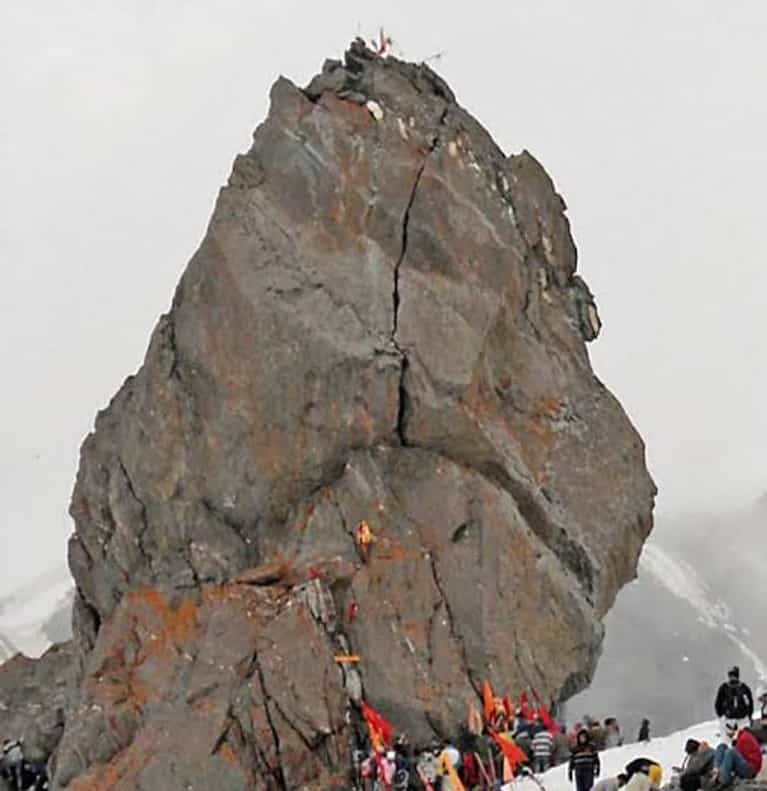

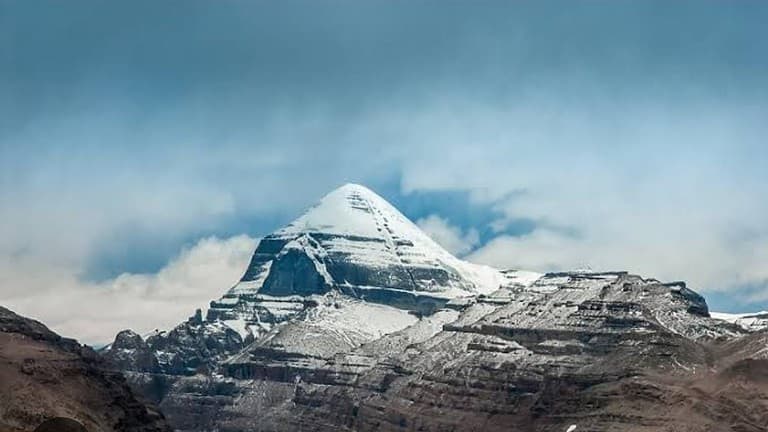
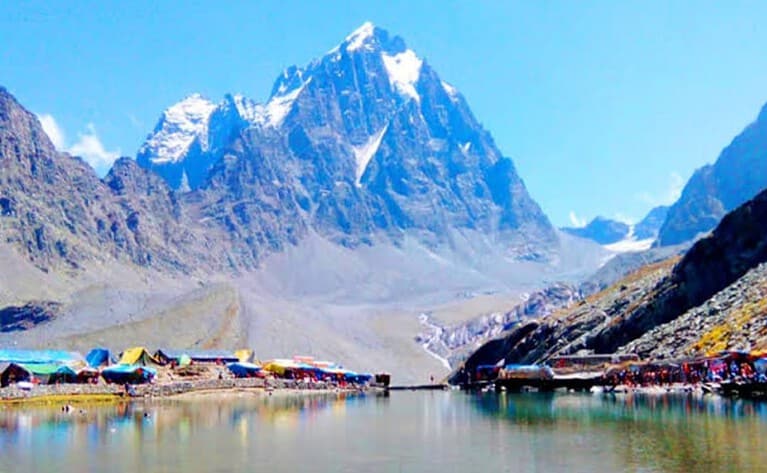

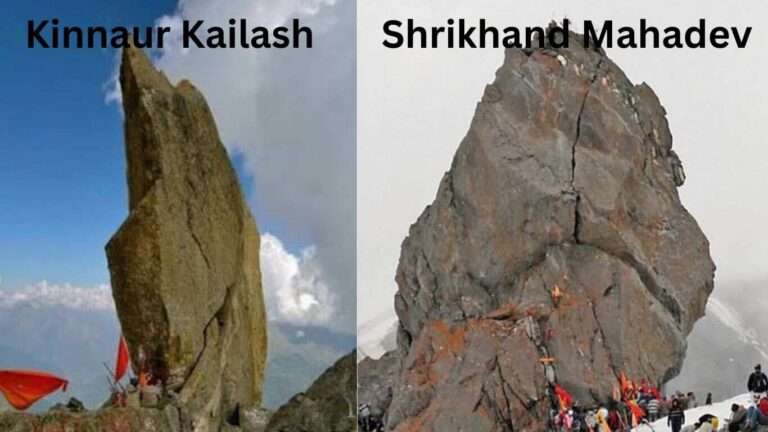
13 Comments